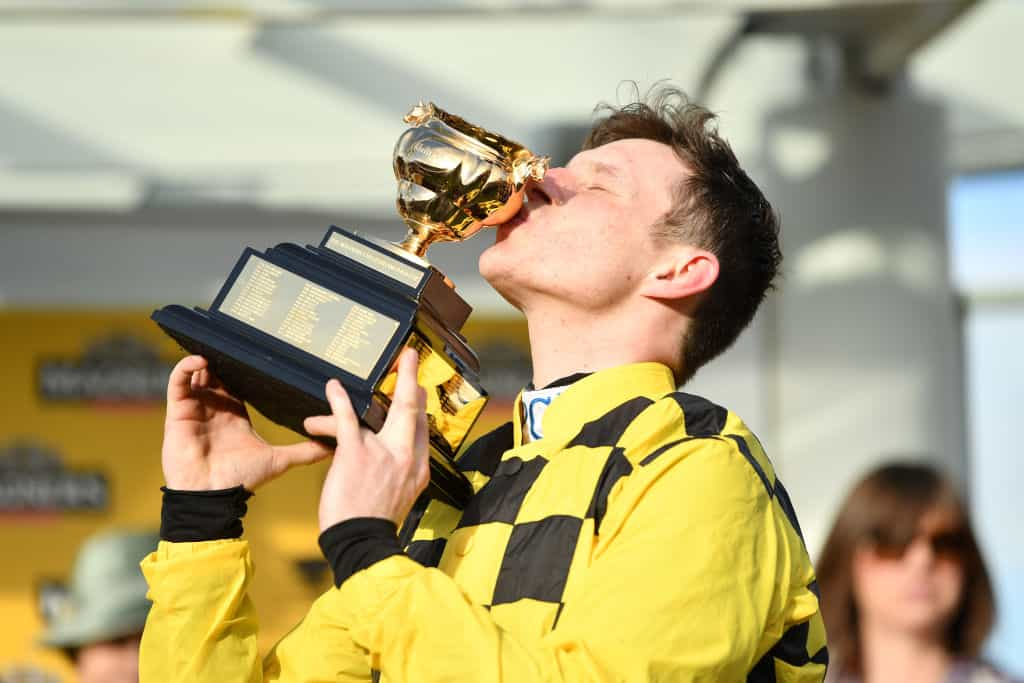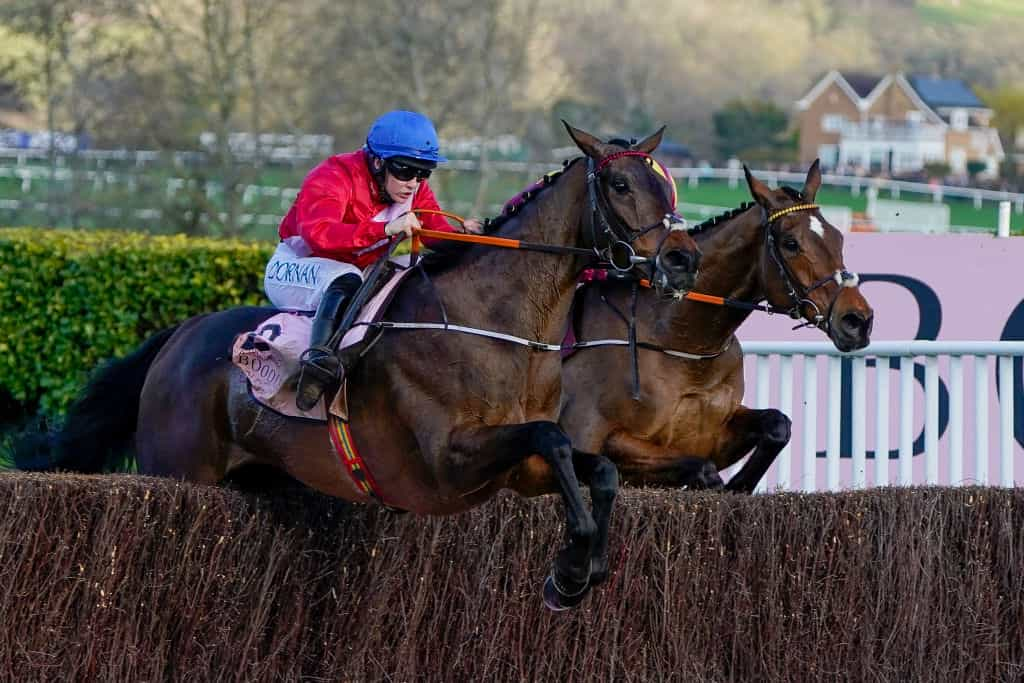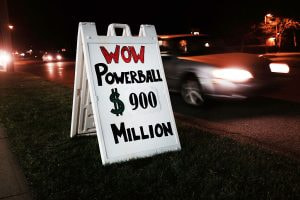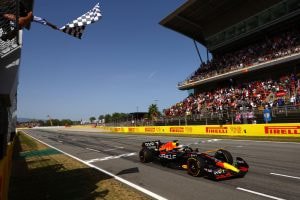The History of the Gold Cup and the Cheltenham Festival
For National Hunt fans, the Cheltenham Festival represents a not-to-be-missed annual pilgrimage. Four days of racing at Prestbury Park, the Mecca of jumps racing, is headlined by the Gold Cup. The famous steeplechase contest is the plinth at the top of the winter sport’s pantheon.
But, ever wondered why Cheltenham, above all other racecourses, established itself as the most prestigious jumps course of all and one of the biggest sports betting markets in the UK? Why there is such rivalry between the stables and owners whose horses represent the UK and Ireland? Or why the Gold Cup is considered the Holy Grail of the sport?

Paul Townend shows what it means to win the Cheltenham Gold Cup. The jockey was successful in 2019 and 2020 aboard Al Boum Photo. ©GettyImages
Let us take you on a trip down memory lane, where we answer those questions, look at the origins of the Festival and the careers of the most famous Cheltenham Gold Cup winners. Furthermore, we will bring things up-to-date by looking at the backstory of the most recent winners of jump racing’s showpiece race, and how it became one of the biggest horse racing betting events of the year.
How Did Horse Racing at Cheltenham Begin?
The first organised race meeting in Cheltenham was a flat card that took place on the edge of Nottingham Hill in 1815. Races staged on the edge of the larger but neighbouring Cleeve Hill started in August 1818. Racing’s popularity in the Cotswolds soared over the next decade.
Crowds of 50,000 reportedly visited the course for an annual two-day July meeting that featured a three-mile ‘Gold Cup’ flat race. But not everyone was so enamoured with horse racing.
In 1829, Cheltenham’s Parish Priest, Reverend Francis Close, preached the evils of horseracing – and the drunkards, pickpockets, and prostitution it attracted. He stirred such strong feelings amongst his congregation that the 1830 race meeting was disrupted by protestors. And, before the following year’s meeting, the grandstand was mysteriously burnt to the ground.
A Grand Annual Event
To overcome this violent opposition, in 1831 the racecourse was moved to Prestbury Park, its current venue. Then, the racing was flat only. However, steeplechasing was established in nearby Andoversford, and its feature race was the four-mile Grand Annual Steeplechase.
The contest predates the first Grand National by two years and is the oldest race in jump racing history. For seven years it was staged at Prestbury Park until the land was sold in 1853. Unfortunately, its new owner did away with horse racing.
The Grand Annual was also discontinued but was restored decades later as a nomadic event staged at, amongst other courses, Melton Mowbray, Warwick, and Leicester. It would finally return to Cheltenham in 1913 and is now recognised as the oldest race at the Festival.
Giving the National Hunt Chase a Home
Cheltenham had its own time in the wilderness. Following its sale to a party that was uninterested in racing, the course was non-existent throughout much of Queen Victoria’s reign. It was not until 1898 that horses thundered around the course in the shadow of Cleeve Hill once again.
Just four years later, Prestbury Park held its first National Hunt Festival; it was a two-day affair. The course became truly established as an exclusive jumps track in 1911 when it gave the National Hunt Chase, a race for amateur riders, a full-time home.
At the time, coming second only to the Grand National, this contest was one of the most prestigious prizes in National Hunt racing. The Grand Annual may be older, but it was absent for much of the late 19th century. Now, the National Hunt Chase has been run more times than any other race at the Cheltenham Festival.
From a Hospital to a Mecca
Two years after the first Stayers Hurdle contest was staged, in 1912, a new grandstand was built at the Prestbury Park Racecourse. However, with the outbreak of the First World War, it was requisitioned as a hospital for those wounded in the conflict in October 1912 and was used for that purpose until February 1919.
The racecourse grandstand, with many balconies and its scenic location in a natural amphitheatre, just below the escarpment of the Cotswold Hills at Cleeve Hill was perfect for the casualties that required tranquil open-air treatment.
When the war ended, what we now recognise as the Cheltenham Festival truly began to take shape. The Cheltenham Gold Cup was run for the first time in 1924, and the Champion Hurdle followed in 1927.
Initially, the Gold Cup was not the centrepiece of the Cheltenham Festival. The National Hunt Chase was the race all owners wanted to win, and the County Hurdle had a bigger prize. Things would change, and Golden Miller’s remarkable achievement of winning five Gold Cups in the 1930s helped make it the feature contest.
Red Made a Splash but Gold Was Golden
Ridden by jockey Dick Rees, the first Cheltenham Gold Cup was won by Red Splash. He is noteworthy amongst Cheltenham Gold Cup winners as he is one of only three horses to have won the contest as a five-year-old.
His owner, Major Humphrey Wyndham, is the first name engraved on the plinth of the perpetual Gold Cup trophy that contains 644 grams of nine-carat gold and is plated in 18-carat gold. Owners of modern-day Gold Cup winners take home a replica of the original Gold Cup.
But it is Golden Miller that most people associate with the early years of the Cheltenham Gold Cup. He was the last five-year-old to win the race (in 1932), and his five victories came under four different jockeys.
Golden Miller’s Gold Cup record could have been even better. His attempt at a sixth Gold Cup in 1937 was scuppered when the Festival was cancelled due to flooding. And he only failed to take the 1939 race by two lengths after he had jumped the last fence ahead.
How Rake and O’Brien Swept Up
The next iconic winner of the gruelling three-mile two-furlong Gold Cup was Cottage Rake. For three successive years between 1948-1950, the Irish-trained horse took contest when aged nine, 10, and 11. In an innovative move, O’Brien flew Cottage Rake to the Festival for his second triumph.
In 1949, using an old air force plane, Vincent O’Brien was the first trainer to fly his horses from Ireland to #Cheltenham This trio all won: Cottage Rake took the Gold Cup, Hatton’s Grace the Champion Hurdle and Castledermot the National Hunt Chase pic.twitter.com/zbTppXptt0
— Sports & Betting History by BestBettingSites (@CDCHistory) March 10, 2020
The success would catapult his trainer Vincent O’Brien, who trained two Cheltenham Gold Cup winners, up the training ranks. Following outstanding subsequent success in both flat and jumps racing, O’Brien always tops the regular greatest trainer of all time polls.
Arkle the Guinness Drinking Irish Hero
It took 16 years for the next Cheltenham Gold Cup threepeat to happen. Once again, the champion was Irish-bred and Irish-trained, his name was Arkle. And, as legends go, Arkle is one of the biggest in jumps racing. To this day, Timeform still rates the 1964, 1965 and 1966 Gold Cup winner as the highest-rated chaser of all time and the greatest of all Cheltenham Gold Cup winners.
Arkle had won at the 1963 Festival – in the Broadway Chase – before his sequence of Gold Cup wins began. By his retirement through injury incurred at the 1966 King George, he had won Punchestown’s Gold Cup, the Irish Grand National (giving 35 pounds or more to every rival), the 1965 King George, and the Whitbread Gold Cup – where he once again gave 35-plus pounds to all rivals.
Arkle won 27 of his 35 starts, which led legendary racing commentator Peter O’Sullevan to describe Arkle as “a freak of nature – something unlikely to be seen again”. The horse became a national hero in Ireland – partially inspired by images of him drinking Guinness.
But his popularity in the UK also cannot be denied. In 1966, the TV Times magazine polled readers on their most-popular personality of the year. Remarkably, The Beatles were only third, Bobby Moore, captain of England’s World Cup-winning squad, was second, and Arkle finished top!
Not the Best but Close
Best Mate, with victories in 2002, 2003 and 2004, is the Gold Cup’s only other three-time winner. Sadly, he never got the recognition his exploits deserved primarily because of the ‘cotton wool’ treatment he was given between his Cheltenham triumphs.
Raced just twice in between his Gold Cup victories during the 2002 and 2003 seasons – and unraced in 2004 ahead of his third success – Best Mate was an infrequent visitor to the racecourse, but he did win or come second in 15 of his 16 chase starts. Tragically he died of a suspected heart attack when making his 2005 debut at Exeter.
Best Mate’s ashes were buried beside the winning post at Cheltenham and there is now a ‘Best Mate Enclosure’ and a statue of the British-trained French-bred champion at the racecourse.
Three More Gold Cup Legends
Claiming the Gold Cup three times is not a requisite for enduring greatness amongst jumps racing fans. L’Escargot, the 1970 and 1971 Gold Cup winner, famed for lowering the colours of Red Rum when taking the 1975 Grand National, is one of the most popular Cheltenham Gold Cup winners.
L’Escargot: Cheltenham Gold Cup and Grand National winner who finished second and third in two other Nationals …he was also a star racer/winner in America (named US Champion Steeplechaser). pic.twitter.com/5xhWAYB3wZ
— Sports & Betting History by BestBettingSites (@CDCHistory) April 15, 2023
Racing Post readers voted the 1989 Gold Cup as ‘the best horse race ever’. It was won on bottomless ground by Desert Orchid, a hugely popular four-time King George winner. The dashing grey remains the most distinguished and popular jumps horse of the past 50 years.
Kauto Star – a five-time King George winner – is rated the best Cheltenham Gold Cup winner of recent times by experts and jumps racing connoisseurs. In 2009 he became the first horse to regain the Gold Cup title after losing the crown he first won in 2007.
Ireland First the UK Nowhere at Cheltenham
In recent years the Cheltenham Gold Cup has been monopolised by Irish-trained horses. Only Coneygree (2015) and Native River (2018) have taken the prize for the home nation. But that has not always been the case and, during the 1980s, an Irish-trained winner at the Cheltenham Festival was as rare as a snowflake in summertime.
Between 1987, 1988, and 1989 inclusive, Ireland enjoyed just two winners at the Cheltenham Festival. And, until 2005, Ireland struggled to muster five winners at the meeting. From 2005, when the Festival became a four-day meeting with 28 races, things slowly changed.
Initially buoyed by a roaring Irish economy and big-spending owners choosing to have their horses trained in Ireland, the Emerald Isle began to prosper, and since 2011, only twice has Ireland had less than 15 winners at the Festival.
The Prestbury Cup – a friendly rivalry/competition introduced in 2014 to win bragging rights on the country that produces the most winners – has not been won by the UK since 2015. In 2021 Ireland enjoyed a 23-5 landslide victory. Some rivalry!
Interesting Cheltenham Festival and Gold Cup Facts
- The 1931 Gold Cup was abandoned due to frost, and the 1937 Gold Cup was scuppered due to flooding.
- The 2001 Cheltenham Festival was cancelled due to a foot-and-mouth outbreak.
- World War II led to the cancellation of the 1943 and 1944 Cheltenham Festivals.
- Pat Taaffe is the most successful Gold Cup jockey of all time. The Irishman won the race on Arkle (1964, 1965, 1966) and Fort Leney (1968).
- In 1987, Gee Armytage became the first jockey to win a race against professionals at the Cheltenham Festival.
- In 2022 Rachael Blackmore became the first female jockey to win the Gold Cup (aboard A Plus Tard).
- At 100/1, the longest-priced of all Cheltenham Gold Cup winners was 1990 scorer Norton’s Coin. The shortest-priced winner was Arkle, the 1/10 favourite in 1966.
- In the 1983 Cheltenham Gold Cup, Michael Dickinson saddled the first five horses home. Bregawn, under Graham Bradley, was the 10/3 winner.
Recent Gold Cup Winners’ Path to Glory
Galopin Des Champs won the 2023 Cheltenham Gold Cup for Willie Mullins. The French-bred horse had already won at the Festival taking the 2021 Martin Pipe Conditional Jockeys Hurdle. The only fall in his career came in the 2022 Turners Novices Chase at the 2022 Festival.
He set the record straight with a sequence of three successive Grade-1 victories – including the Irish Gold Cup – before scoring by a convincing seven lengths as the 7/5 favourite in the 99th Cheltenham Gold Cup in March.
Big Tick for a Plus Tard
Famed for providing a female rider with a first Cheltenham Gold Cup success, A Plus Tard’s path to victory in jumps racing’s blue riband event is an interesting one. The former French racer first experienced Prestbury Park when winning the 20-runner Close Brothers Novices Handicap Chase at the 2019 Festival by 16 lengths.

Rachael Blackmore on A Plus Tard became the first female jockey to win the Cheltenham Gold Cup in 2022. ©GettyImages
He returned to Cheltenham in 2020 to finish third in the Ryanair Chase. Just two runs later, A Plus Tard booked his place in the 2021 Gold Cup field with success in the Grade-1 Savills Chase at Leopardstown.
Still only aged seven, A Plus Tard ran brilliantly to come second to Minella Indo. Using the Best Mate rule book, trainer Henry De Bromhead ran his horse just twice more before contesting and winning the Gold Cup 12 months later. In doing so, he reversed his 2021 Cheltenham Gold Cup form with Minella Indo by almost 17 lengths.
Back Class Was Enough for Indo
The horse that got the recent sequence of winning a race at the Festival before taking the feature three-mile two-furlong chase underway was Minella Indo. This Irish-bred and trained star took the 2019 Albert Bartlett Novices’ Hurdle at odds of 50/1.
It was no fluke. In 2020 he signalled his class by being beaten just a length in the RSA Novices’ Chase at the Festival. It was a race that Cheltenham Gold Cup winners Bobs Worth (2012) and Lord Windermere (2013) had won before landing the Gold Cup.
Nevertheless, Minella Indo started 9/1 for his Gold Cup success – and for good reason. He had fallen in the Savills Chase over the Christmas period, and his fourth of five runners in the Irish Gold Cup meant he was dismissed by many for his next assignment, the 2021 Gold Cup.
On the big day, with all eyes on Al Boum Photo – who was chasing a third consecutive Gold Cup success – Minella Indo led three fences from home and ground out a game and gritty success that spearheaded a perfect 1-2-3 finish for the Irish.



